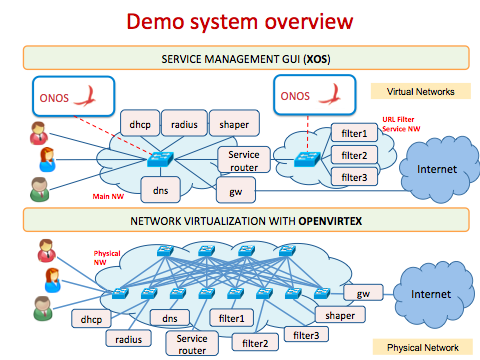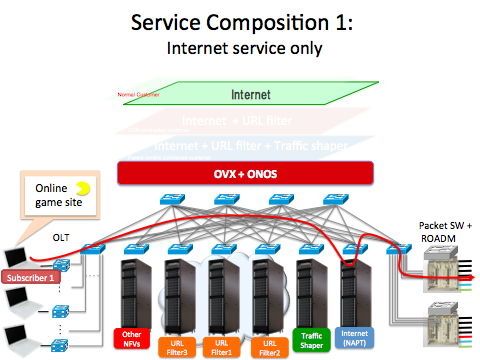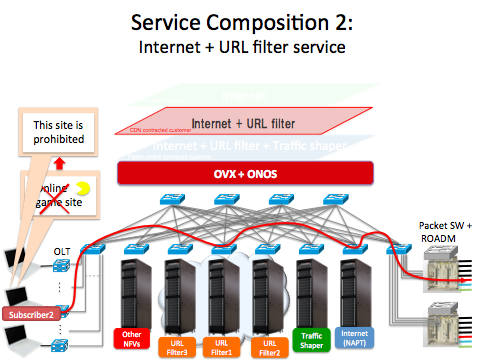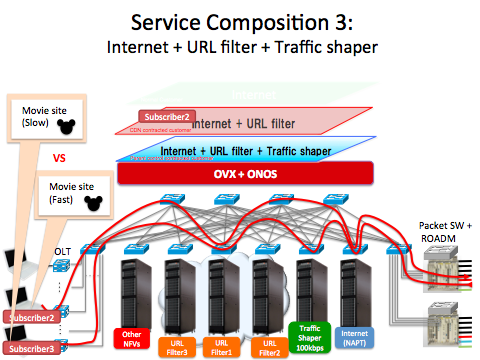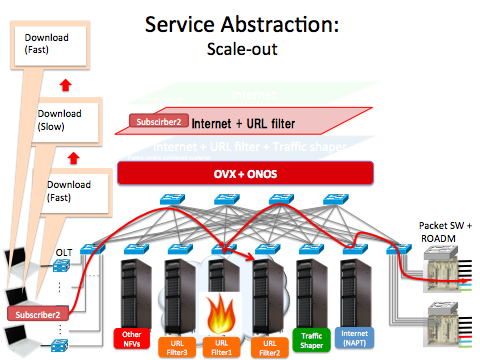This is the system architecture overview for this demo. On the bottom, we have physical topology.
The topology is emulated by Mininet on a bare metal server and on the top of it, we use OVX.
OVX makes 2 virtual networks, main network and URL Filter service network.
Each virtual network is managed by its own ONOS cluster.
We deployed management GUI on top of them to manage subscribers and services.
At first, we will show a simplest service composition.
This composition contains only the Internet connectivity service. At first, subscriber1 can’t access to any sites from its browser. From GUI, we will assign Internet connectivity service to subscriber1. And after this operation, ONOS pushes flows using Intent framework and that makes subscriber1 can access to the Internet. Now, subscriber1 can access to the Internet by this GUI operation.
Secondly, we will show the second service composition, Internet + URL filter service. From GUI, we will assign Internet + URL filter service to subscriber2.
At first subscriber2 can‘t access anywhere because of the lack of service composition. From the management GUI, we will add internet and url filter services to subscriber2. It causes pushing proper service composition flows and now the subscriber2 can access the Internet via URL filter service. Now subscriber2 try to access some online game site, but url filter redirects his access to this error page because when subscriber2 tries to access some sites, the filter service catch his requested url is on its blacklist and redirects its access to an error page.
Thirdly, we will show internet + url fitler + traffice shaper as the third service composition case. Now we assign Internet + URL filter + traffic shaper service composition to subscriber3. This makes subscriber3 can access to the internet, but at slower speed. Subscriber2 doesn‘t have traffic shaper, so he can access the Internet at full speed. Subscriber2 doesn‘t have traffic shaper, so he can access the Internet at full speed. Now he will access to "YouTube" site and watch some video, and he can watch it smoothly. On the other hand, From subscriber3 browser, even he tries to access the same page, his video is pretty slow, because he has traffic shaper service and his bandwidth is limited by it.
Finally, we want to show service abstraction example. We want to show you URL filter service scale out.At first, the subscriber 2 is downloading some big file from the Internet. After he starts downloading a big file, the speed of the downloading is around 8Mbps. Now we add some heavy load on the filter server. It causes speed down of the downloading. From GUI, we push the scale out button and it will spawn a VM and push flows for it. This action results in recovering the download speed to the same level as before.
